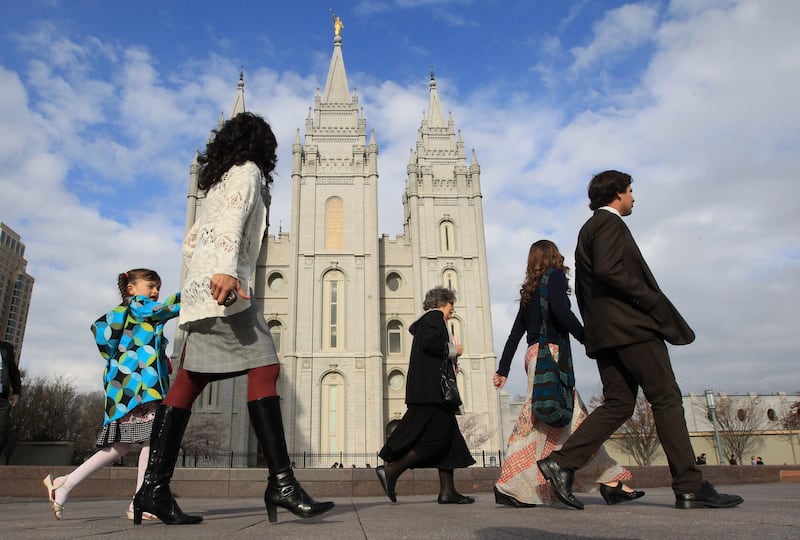SALT LAKE CITY — Anti-Semitism and Islamophobia are on the rise, but so are crimes against members of The Church of Jesus Christ of Latter-day Saints, according to hate crime statistics from the FBI released in December.
The FBI documented 15 "anti-Mormon" hate crimes, or crimes specifically targeting Latter-day Saints, in 2017. That's roughly twice the seven "anti-Mormon" hate crimes recorded in 2016 or the eight in 2015, when the bureau first started tracking bias-motivated offenses against religious minorities including Jehovah's Witnesses, Sikhs, Buddhists, Hindus and Orthodox Christians.
These hate crimes against Latter-day Saints make up only a small fraction of offenses, however.
In 2017, the most frequently victimized religious group was Jews, with 938 anti-Jewish incidents. The second most targeted group was Muslims, with 273 incidents. While there were fewer anti-Islamic incidents in 2017 than in 2016, hate crimes against both groups have increased significantly in recent years. Most notably, anti-Jewish incidents jumped about 37 percent between 2016 and 2017.

"Across the board, hate crimes against religious minorities are rising," said Brian Levin, director of the Center for the Study of Hate and Extremism at California State University, San Bernardino.
Data show there were more hate crimes motivated by religious bias in 2017 than any previous year. But experts like Levin say the growing numbers may be due in part to increased reporting from police departments rather than simply increased violence.
Because of the partial government shutdown, the FBI was unable to respond to a request for comment.
The FBI defines a hate crime as a "criminal offense against a person or property motivated in whole or in part by an offender’s bias against a race, religion, disability, sexual orientation, ethnicity, gender or gender identity.”
According to Salt Lake County District Attorney Sim Gill, the difference between a hate crime and a normal crime is the impact on a community.
"If a community hears that LDS people are being targeted and assaulted by a group of people, every parent sending their child to church on Sunday or whose child is serving a mission is going to feel that terror," Gill said. "That terror is the direct result of that criminal activity occurring in the community."

Gill, who was born in India and raised in the Sikh tradition, has been advocating for 18 years for a stricter hate crime law in Utah to make it easier to increase sentences for offenders. A recent beating of two Latino men in Salt Lake City by a man who announced his intention to "kill a Mexican" has revived discussion of this topic once again.
"Unwillingness to hold criminals accountable for the whole impact of their actions is where we fail to deliver justice to those injured communities," Gill said, noting that Utah's law is vague and only applies to misdemeanors.
The FBI has been investigating hate crimes since World War I. But only since 2015 has the bureau paid special attention to members of The Church of Jesus Christ of Latter-day Saints, following a 2013 recommendation to include more minority groups that was signed by more than 100 members of Congress, The Washington Post reported.
Unwillingness to hold criminals accountable for the whole impact of their actions is where we fail to deliver justice to those injured communities. – Salt Lake County District Attorney Sim Gill
A 2012 mass shooting at a Sikh temple in Wisconsin that left six dead was a motivating factor for the recommendation, Levin said. At that time, signees petitioned for the inclusion of all self-identified religions in the United States as listed in the Pew Research Center’s Religious Landscape Survey (2008) and the Statistical Abstract approved by the U.S. Census Bureau (2012), according to The Washington Post.
Levin attributes the national rise in hate crimes to expanding population and diversification in the United States.
"People are fearful witnessing cultural and demographic changes," he said.

Islam and The Church of Jesus Christ of Latter-day Saints are two religious populations that are growing in the United States, said Levin.
The number of Muslims in the U.S. grew from 2.35 million in 2007 to 3.45 million in 2017, mainly due to immigration, according to Pew Research Center.
At the same time, U.S. membership of The Church of Jesus Christ went from 5.87 million at the end of 2007 to 6.64 million today, according to church statistics.
"When we have demographic changes, what it tells us is we're seeing a shift," he said. "For some people, the reaction to change is fear and violence."
White nationalism and anti-Semitic discourse online are also becoming more prevalent, said Levin, explaining the rise in anti-Jewish hate crimes.
"What I think we're seeing as a nation is the democratization of hate. We're not only polarized with respect to traditional categories like race and religion, but also some categories that the FBI numbers don't capture, like political divisions," said Levin.

But the FBI data could be misleading, according to Jack Levin, co-director of the Brudnick Center on Violence and Conflict at Northeastern University (and no relation to Brian Levin of California State University).
He said the FBI statistics are the best hate crime data that exist, but they still don't entirely reflect reality. Because the reporting is voluntary by police jurisdictions around the country, each year a different number of police departments participate.
That means it's difficult to compare the number of hate crimes from year to year and from one state to another, said Jack Levin. What is certain is that the actual number of hate crimes is higher than what's reported.
"Underrepresented and vulnerable groups are the recipients of hate crime threats. They are also the groups that are most likely to underreport," he said.


